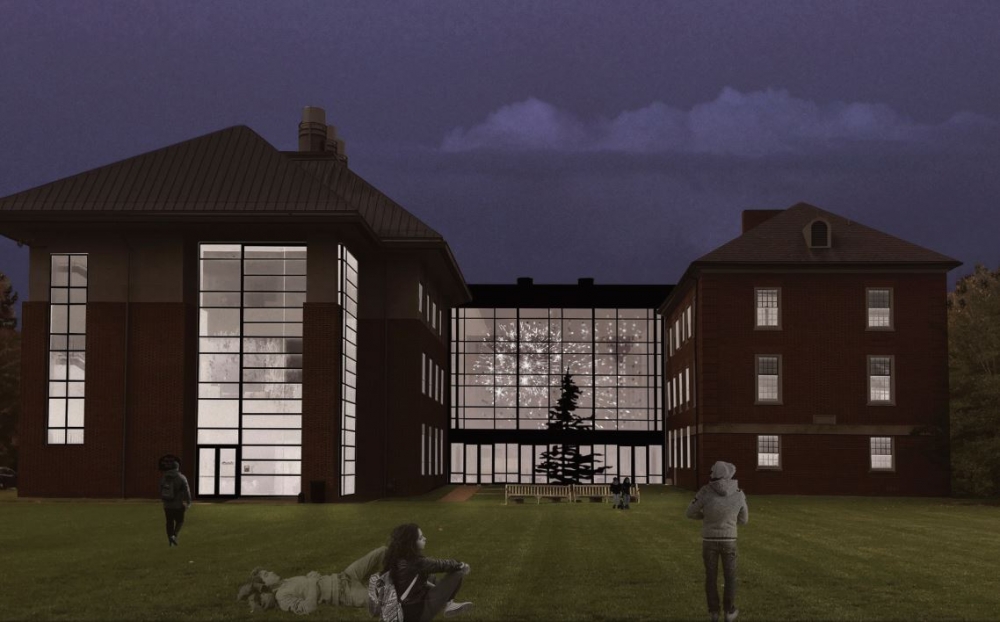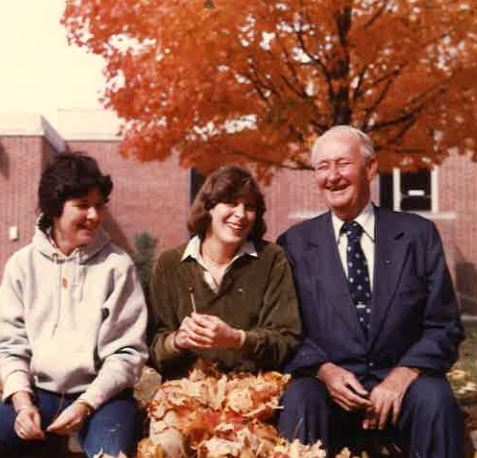
An artist’s rendering of “Radiant Echo,” the light sculpture to be installed at Washington College as seen from the green
Former Washington College President Joseph McLain is remembered for many things – but his most enduring legacy may well be the tradition of fireworks displays at the college.

Joseph McLain shares a laugh with students
McLain, a chemistry professor with a lifelong interest in pyrotechnics, attended Washington College as an undergraduate. After college, he served in the World War II chemical corps, working on such projects as an improved hand grenade fuse and underwater cutting torches. After the war, he earned his Ph.D. in chemistry at Johns Hopkins, then returned to Washington College to teach. Over the course of his career, he made the college a center for the study of fireworks, both in the academic community and in the commercial fireworks industry. His work focused, among other things, on improving fireworks ignition systems so as to avoid timing errors, which can be dangerous as well as spoiling the artistic effect of a display. He became the 22nd president of the college in 1973 and served until his death in 1981 — the only alumnus ever to fill the position. McLain was also responsible for establishing the annual Fourth of July fireworks show in Chestertown, which he staged on the Washington College campus.

John Conkling
In 1969, McLain hired one of his former students – John Conkling, also a Hopkins Ph.D. – to join the chemistry faculty at the college. McLain steered Conkling toward the study of pyrotechnics, which resulted in the first federal safety standards for fireworks, jointly created by the two and enacted in 1976 by the U.S. Consumer Products Safety Commission. In 1985, Conkling resigned his full-time teaching position to become Executive Director of the American Pyrotechnics Association– a position he held until 1998. He continued to teach adjunct courses without taking a salary, and hosted the annual Summer Pyrotechnics Seminars at Washington College.
Largely because of the legacy of McLain and Conkling, fireworks displays have become a tradition at Washington College, welcoming students back to campus in the fall and celebrating graduation and other occasions such as the inauguration of current president Kurt Landgraf. Residents near the college often come out to see the shows, which are visible and audible from a wide area of the town.
Chestertown also had a history of fireworks before McLain, most notably with the Kent Manufacturing plant, which, beginning in 1941, produced defense materiel for World War II and then added fireworks to its line after the war. After his return to Chestertown, McLain became a partner in the business, along with founder Tony Fabrizi, whom he had met during his time in the service. That venture came to an end when a fire and explosion destroyed the plant in 1954. But McLain continued to work with the pyrotechnics industry, with a special interest in safety standards.
Now, to create a more permanent monument to McLain, Conkling and their pyrotechnics work, McLain’s daughter Lynn McLain, is raising funds for “Radiant Echo,” an innovative art installation planned for the atrium of the Toll Science Center at the college. Intended to serve as an enduring art piece for the college and the town of Chestertown, “Radant Echo,” designed by Flux Studio of Baltimore, will be a three- dimensional grid of LED fixtures suspended in the 3-story atrium. The fixtures, which will hang to within 14 feet of the floor, will flash and flicker in emulation of a fireworks display, with chrome spheres suspended within the field to reflect and amplify the lights. According to a prospectus for the program, “As with fireworks, spectators will know that something will happen, but they won’t know exactly what, or exactly when.”

An artist’s rendering of”Radiant Echo” as seen from inside the atrium
The prospectus adds, “The choreography of the sculpture will draw from both the chemical behavior of fireworks and the phenomenal experience of observing them, contrasting familiar aerial exploding with inward collapsing at the atomic scale.” It will be programmed to operate in two states, depending on the time of day. Its default, resting state will feature short bursts of light at the outer edges of the sculpture, a “momentary flickering at the corner of one’s eye that vanishes almost as soon as it appears.” In its nighttime, or active, state, the tentative flickerings will “crescendo and then explode, piercing the darkness and dissolving into a cascading shower of light. At times the whole sculpture will erupt in a cacophony of explosions, recalling the grand finale of a fireworks show.” The displays will be visible from the campus green outside Toll Science Center and from Washington Avenue.as well as to those inside the building.
“Radiant Echo” will also have an educational function. Glenn Shrum, who designed the sculpture, plans to teach an interdisciplinary workshop while the piece is being installed. Also, college faculty will be able to use the sculpture in their classes on physics, chemistry, psychology, computer programming, and art. And as part of its installation, there will be a symposium on fireworks drawing on many different disciplines. There will also be a public honoring of Dr. Conkling and his wife Sandy.
Lynn McLain said on Jan. 7 that she hopes fundraising for the project will be completed within the year. Installation of the project is expected to take 14 to 16 months, she said. The final contacts for the construction of the project are in process.
To help promote the project, Lynn McLain has written an illustrated coffee-table book, For the Love of Fireworks, published in 2017. Proceeds from the book will help to fund the creation of “Radiant Echo.” The book is full of fascinating detail and would make a great gift. The book explores the history and cultural associations of fireworks, and includes a series of trivia questions such as when fireworks were invented, where the largest fireworks display on record took place, components used in their manufacture, and so forth. For the Love of Fireworks is available online at $56.99 from Amazon and other online booksellers. Or buy the book, hard or softcover, directly from author McLain at https://www.loveoffireworks.com . The price is the same and a direct purchase, McLain said, will result in a larger contribution to the project.
Fundraising is underway to cover the estimated $250,000 cost of building and installing “Raidant Echo.” McLain said on Jan. 7 that the campaign had raised just over $100,000. To contribute to the effort, contact Lynn McLain at 410-778-4515 or [email protected]. You can also contribute through the Washington College Office of Advancement at 410-778-7801. Checks can be made out to the Washington College Office of Advancement, with “Atrium Sculpture Project” in the memo line. The address is Washington College Office of Advancement, 300 Washington Ave., Chestertown, MD 21620.
And then look forward to fabulous firework displays on Washington College campus, both real and simulated via “Radiant Echo.”



Lynn McLain says
Thank you for the great article! I can’t wait until the artwork becomes a reality for all in town to see! One correction: the contracts are just in process, not yet signed. One addition: the books, both hard and softback, can also be found at http://www.loveoffireworks.com. Thanks so much!
Sean Meade says
I cannot begin to describe how happy I am to see this moving forward. Glad to see the College embracing art again. Also happy to see an artifact of SANDBOX lingering on.